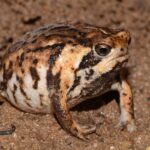- Atelopus ardila: Unveiling the Secrets of Colombia's Enigmatic Harlequin Toad
- Taxonomy and Classification
- Natural Habitat: A Hidden Treasure in the Andes
- Physical Characteristics: A Living Work of Art
- Behavior and Life Cycle: Tales of Survival and Courtship
- Ecological Role: Indicators of an Ecosystem's Health
- Threats and Conservation Status: A Race Against Extinction
- Cultural and Scientific Significance
- Conclusion: An Amphibian Icon Worth Protecting
Atelopus ardila: Unveiling the Secrets of Colombia’s Enigmatic Harlequin Toad#
Hidden among the lush forests and crystal-clear streams of Colombia’s spectacular Andes Mountains lives a tiny, colorful amphibian whose fate mirrors the delicate balance of our planet itself. Meet Atelopus ardila, a harlequin toad whose vibrant appearance and compelling story weave together beauty, fragility, and resilience in equal measure. Known affectionately among conservationists and amphibian enthusiasts as Ardila’s Harlequin Frog, this fascinating species is at once wondrously charismatic and tragically vulnerable—making its story all the more important to tell.
Uniquely adorned with striking coloration that boldly announces its presence to predators and admirers alike, Atelopus ardila belongs to the Bufonidae family and has become an emblematic amphibian species of the threatened Andean ecosystems. One intriguing aspect that captivates both scientists and nature enthusiasts is the fact that despite its vibrant hue, relatively little is widely known about its secretive lifestyle and ecology. As we delve deeper into the remarkable world of Atelopus ardila, we gain insight into the delicate threads connecting species, habitats, conservation, and humanity.
Taxonomy and Classification#
An intimate journey with our amphibious friend begins, naturally, by understanding its taxonomic heritage. Atelopus ardila is a distinct representative in the genus Atelopus, a diverse and highly recognizable group of amphibians commonly known as harlequin frogs or stubfoot toads. This genus has earned considerable biological and conservation attention due to its vibrant coloration, fascinating behaviors, and—unfortunately—its alarming vulnerability to extinction.
Nested within the Bufonidae family, harlequin frogs have evolved unique adaptations differentiating them from common toads. Unlike their terrestrial cousins, members of the genus Atelopus typically display slender physiques and boldly colorful skin patterns, often acting as vivid warnings to potential predators. Closely related species include Atelopus varius and Atelopus zeteki, equally known for their resplendent appearances and precarious survival status. Together, they cast an ecological spotlight that calls attention not only to their own plight but to the broader environmental crisis unfolding across their native range.
Natural Habitat: A Hidden Treasure in the Andes#
To truly comprehend the special nature of Atelopus ardila, one must immerse oneself in its vibrant and enchanting natural surroundings. Found exclusively in Colombia—specifically in the Serranía de los Yariguíes, part of the Colombian Andes—these harlequin toads sculpt their lives amidst tropical montane forests teeming with lush foliage, crystalline freshwater streams, and a chorus of birdcalls punctuated by the occasional song of fellow amphibians.
The niche that Atelopus ardila occupies is particular and highly specialized. These delicate amphibians prefer humid, shaded areas adjacent to clean and slow-flowing mountain streams, where forest cover provides shelter and an abundance of prey insects. Moss-covered rocks and leaf litter cluttered beneath dense canopies become their ideal microhabitat, offering protection from predators and suitable places for breeding behaviors.
The streams themselves play an irreplaceable part in the species’ ecosystem, serving as nurseries for their tadpole offspring. The health of these aquatic habitats is dependent upon the surrounding forests, and consequently, the decline in forest cover, degradation from agricultural runoff, or mining activities can spell disaster for these fragile amphibians. Understanding their profound dependence on healthy, old-growth forests underscores how ardently connected their survival is to pristine environmental stewardship.
Physical Characteristics: A Living Work of Art#
Few creatures on Earth exhibit the bold exuberance expressed through the vivid skin patterns of the Ardila’s Harlequin Frog. Measuring just 3 to 4 centimeters in length, what this species lacks in stature it more than compensates for in visual spectacle. Their bodies bear striking hues ranging from luminous yellows and oranges to intense, contrasting black markings, creating a flamboyant mosaic—an extravagant natural costume designed to signal danger.
Bright colorations like these function as aposematic warnings, indicating the presence of toxins secreted through specialized skin glands. Through this evolutionary marvel, Atelopus ardila deters predators effectively, reducing instances of attacks while saving precious physical energy. Apart from their splendid coloration, their smooth, slender bodies exhibit adaptations optimized for a semi-aquatic lifestyle. The presence of reduced webbing between their fingers and toes, combined with elongated limbs, signifies their evolutionary adaptation for both hopping along terrestrial habitats and climbing moist rocks along stream banks.
Behavior and Life Cycle: Tales of Survival and Courtship#
In the lush confines of the Colombian Andes, life unfolds in delicate precision. Like other amphibians of the Atelopus genus, Ardila’s Harlequin Frogs exhibit unique behaviors and intimate rituals. A daytime active species, their languid yet vigilant movements over moss-covered stones near gently flowing water leave subtle clues to their ecological roles as active insectivores, feeding primarily on ants, tiny beetles, and small invertebrates abundant in their habitat.
Mating behaviors: A dramatic encounter#
When rains intensify and humid mists emerge, signaling the arrival of breeding season, male Atelopus ardila congregate along the stream banks, emitting soft but remarkably melodic calls with gentle clicking sounds to attract females. During these communal gatherings, males often compete for the best vantage points, assertively defending their chosen territories with behaviors combining visual gestures and vocal displays.
Upon arrival, females select prospective partners based not only on call characteristics but also on the strategic quality and location of the male’s territory. After a successful courtship, the pair engages in amplexus, a form of mating behavior characterized by the male gripping tightly to the female’s back to externally fertilize eggs as she releases them into the safely concealed, shallow aquatic spaces. Eggs embedded beneath submerged rocks hatch into tiny tadpoles, exquisitely adapted to living in quiet, protected pools where they sustain themselves by grazing algae and organic detritus.
From this humble beginning in quiet mountain pools, they embark on an extraordinary journey of metamorphosis—from vulnerable, aquatic tadpoles into fully terrestrial but water-loving adults. Each life cycle stage is carefully attuned to their fragile, specialized habitats, all intricately tied to the health of pristine forests and streams.
Ecological Role: Indicators of an Ecosystem’s Health#
Amphibians like Atelopus ardila bear significant responsibility within their fragile mountain ecosystems. Acting as vital indicators, these harlequin toads help reveal the ecological health and stability of their surroundings, relying heavily and sensitively on the quality of both terrestrial and aquatic habitats. Being voracious insectivores, they play a critical role controlling insect vector populations and maintaining a balanced ecosystem.
Simultaneously, they represent essential prey species for certain predators, despite their defensive toxins. Amphibian declines—as alarmingly prevalent as they are—can disrupt finer ecological balances, cascading impacts through intricate food webs and eventually compromising entire ecosystem services, from clean water provision to insect population dynamics.
Threats and Conservation Status: A Race Against Extinction#
Unfortunately, Atelopus ardila faces critically steep conservation challenges. Classified as Critically Endangered by the International Union for Conservation of Nature (IUCN), their decline echoes global trends among amphibians—primarily driven by habitat loss, pollutive agricultural practices, mining activities, and more recently, the pervasive fungal disease chytridiomycosis (caused by Batrachochytrium dendrobatidis). Climate-associated changes are compounding these threats, destabilizing the very moisture regimes that fragile species like the Ardila’s toad require.
In response, dedicated conservation teams have embarked on ambitious efforts to protect critical habitats within Colombia’s remaining forests, enact stricter regulations against pollution and fragmentation, and research solutions to the devastating chytrid fungus. Captive breeding programs and environmental education initiatives also emerge as vital conservation strategies, highlighting both hope for the species and an urgent call for continued international attention and aid.
Cultural and Scientific Significance#
The captivating beauty and perilous plight of the Ardila’s Harlequin Frog extend beyond ecology, influencing Colombian culture and scientific research. Local folklore often ascribes symbolic significance to uniquely colored amphibians, associating them with environmental health, cultural fortune, or spiritual markers.
From a scientific perspective, understanding the ecological requirements and conservation dynamics surrounding Atelopus ardila contributes invaluable insight into bioindicator research, biodiversity assessments, and ecosystem management strategies, helping preserve many species awaiting critical conservation.
Conclusion: An Amphibian Icon Worth Protecting#
Atelopus ardila isn’t merely an isolated species; it is a living symbol of interconnectedness, revealing a narrative that integrates science, conservation, and humanity. Ultimately, protecting Ardila’s Harlequin Frog means safeguarding the spectacularly pristine ecosystems of Colombia, as well as preserving a mesmerizing piece of our living natural heritage.
As stewards entrusted with the fate of our planet’s biodiversity, we must amplify our collective voice, advocating urgently for the conservation and protection of these incredible species and habitats. Let us heed the lessons these vibrant amphibians teach and pursue bold, compassionate actions to ensure that the hauntingly beautiful song of Ardila’s Harlequin Frog continues to echo amid the misty Andean mountains for generations to come.







